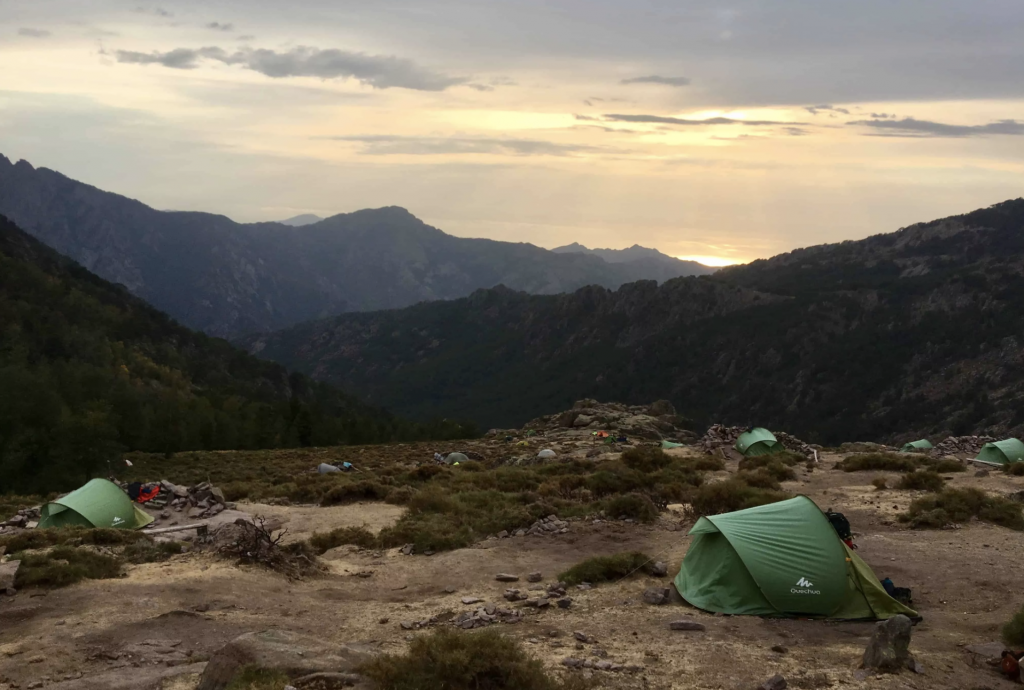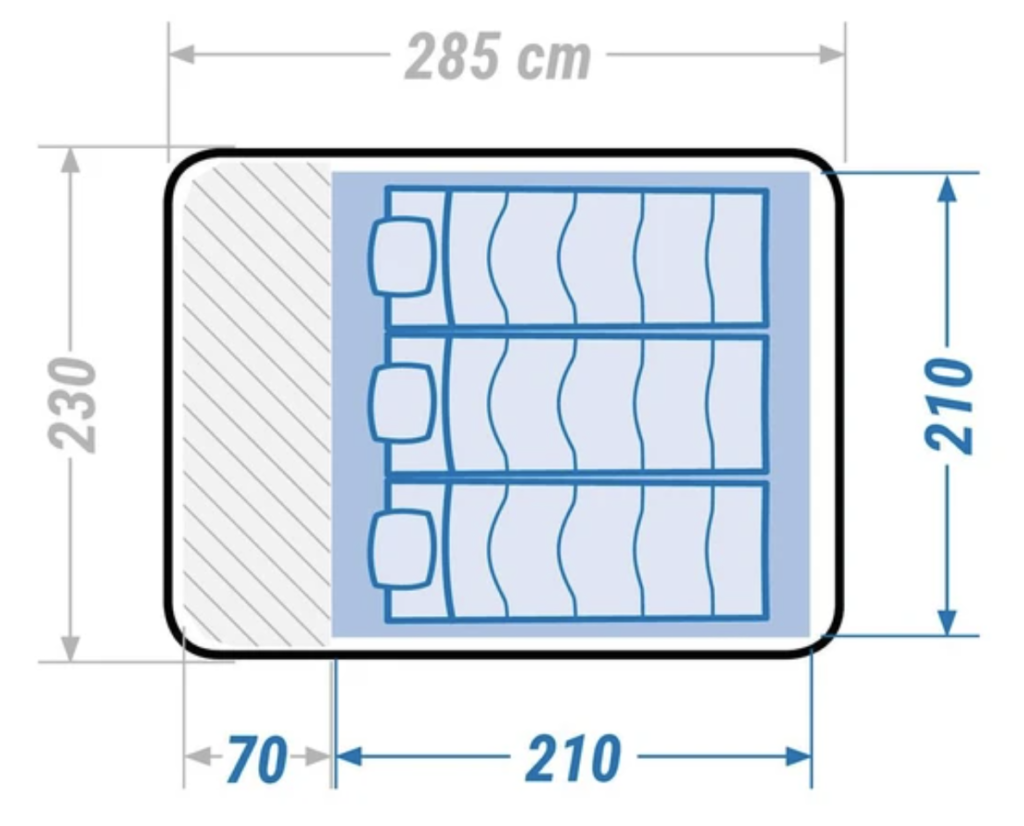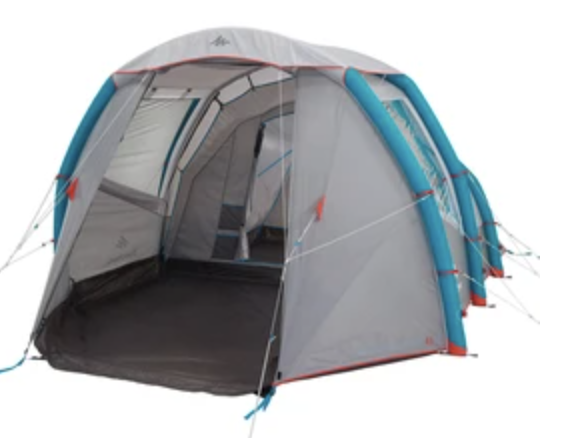
Here are our thoughts on whether Decathlon (Quechua) Tents are good.
When I first started camping a few years ago, I had a tent that leaked in the rain. It was an unpleasant experience that taught me the importance of a quality shelter.
Since then, I’ve tried many tents and researched even more. If you’re wondering if Quechua by Decathlon makes good tents, I’ve got a great answer for you:
Quechua’s 2 Second Fresh & Black Tent is an excellent pop-up tent. It’s highly waterproof, durable, and, most notably, blocks out the sun. If you are camping with family and friends, the Arpenaz 4.1 4-person is one of the most livable tents in its price range. But the Forclaz backpacking tent lags behind its competitors.
Let’s jump right in.
Decathlon Tents Brand Overview
You may know Decathlon as the global outdoor gear chain as it is today, but it had a humble beginning. The first Decathlon store was opened in 1976 in France, more than 2 decades later than other major brands like Coleman or Kelty. Decathlon’s growth is quite impressive.
With the mission of bringing the benefits of sports to everyone, Decathlon created 20 passion brands across multiple outdoor activities. And Quechua is Decathlon’s brand of tent.
Quechua is known for its innovation. The classic 2 Second Fresh & Black tents come with a unique blackout fabric that blocks heat and light. It’s also one of the most durable and waterproof pop-up tents on the market.
Quechua 2 Second Fresh & Black Pop Up Tents
I’ve looked at many pop-up tents, and let me say, the Quechua 2-second Fresh & Black is one of the best ones out there, packed with features.
It comes in both 2-person and 3-person capacities. Many characteristics are the same across both models.
Click here for Decathlon Quechua tent comparison table with full specs
Quechua 2 Second Fresh & Black
You may wonder what Fresh & Black in its name means. It refers to a special blackout fabric used that keeps the inside cool (fresh) and dark even after the sun rises (black).
This means you can actually enjoy some sleep-ins and not be woken up by the early morning sun. Then you’ll have all the energy you need for a day filled with outdoor adventures.
But like everything else, there are tradeoffs. There isn’t any mesh on the ceiling for stargazing and ventilation. It just doesn’t go together with the blackout fabrics.
The Quechua 2 Second Fresh & Black is also highly waterproof.
The fly and walls have a waterproof rating of 2000mm, which means it should handle moderate rain with no issues even after some wear and tear. This is further validated by buyer reviews that say the tent has kept them dry in a rainstorm.
Decathlon didn’t specify the waterproof rating of the floor, but I’m sure it’s at least 2000mm. That being said, I still recommend you use a footprint to protect the bottom.
The Quechua 2 Second features 2 side panels you can open from outside to reveal meshed walls for ventilation. The rear flysheet can also be opened from the inside.
But the meshed walls are smaller than many other pop-up tents, and it doesn’t come with a meshed ceiling. People have reported condensation on the rainfly, though the inside of the tent didn’t get wet.
Also, you can only open the side panels/flaps from outside the tent and need a guy rope to extend them fully. So adjusting them can be a bit inconvenient.
Again, this tent is extremely easy to set up, but “2 second” is an exaggeration. The tent forms its shape in less than 30 seconds once you remove all the buckles. But as shown in the video, you will need 1 minute or 2 to stake it down. Still, it’s much faster to set up than a traditional tent.
In terms of interior space, the Quechua 2-second is pretty standard in its class. The 3-person model has a width of 71”, so each person would get 24”. This is going to be pretty tight as you consider a queen-sized bed 60” wide. The peak height of 41” means most people can sit up and still have extra headroom.
Pros:
- Very fast to set up
- Won’t overheat
- Remain dark after sun rise for better sleep
- Waterproof in most rain showers, though using it in heavy rain is not recommended
- Breathable as you can lift the rain fly and side panels
- Tested to be sturdy in winds up to 30mph; average wind speed is 6 – 12mph
- Many interior storage pockets
- 2-person model is lightweight enough for short backpacking trips
Cons:
- No meshed ceiling for stargazing
- Side panels can only be opened from the outside
- Can get a bit cramped inside with 2 or 3 people; recommend sizing up
The competition:
The Quechua 2-second Fresh & Black is pretty much the only pop-up tent on the market with special black-out fabrics. If you want to go without it, here are some other options:
- Coleman 2/4-person pop-up tent – cheaper alternative with meshed roof for stargazing and removable rainfly; no blackout fabrics; harder to fold up; could have durability issues with zippers not working and poles snapping
- OT QOMOTOP 4 Person Pop up Tent – similarly priced with larger interior space, large windows with excellent ventilation; no blackout fabrics; unclear waterproof rating
- HUI LINGYANG 6 Person Easy Pop Up Tent – larger capacity at similar price points, large vestibule on one side, waterproof even in heavy rain (3000mm+ rating), no blackout fabrics; difficult to fold up
Quechua 2 Seconds XL Fresh & Black – 3 person
As the name suggests, the Quechua 2 Second XL Fresh & Black is a larger version of the Quechua tents we reviewed above.
The 3 person model is 83” wide, 12” wider than the regular-sized one. Each person would get around 4 inches or 10cm of extra space. Below is an illustration from the manufacturer’s website.

Besides the size difference, everything is the same: the same structure, fresh & black fabric, waterproofing, side panels, and setup.
The pros and cons are also the same, besides the added bonus of larger capacity.
Quechua 2 Second Easy Fresh & Black – 2 person
This is a 2-person tent but with a slightly different structure:
Compared to the regular Quechua 2 people Fresh & Black tent, it’s also 10” wider, meaning each camper would get 5” of extra space. It’ll feel similar to two people sleeping on one queen-sized bed, which is still pretty tight. It’ll be very comfortable for one person.
You can also set it up in under 1 minute.
Click here for Decathlon Quechua tent comparison table with full specs
What to Look for In Pop-Up Tents
Pop-up tents gained popularity over the years for their ease of set-up. Most can be put up in less than 30 seconds.
How is this possible, you ask? Well, pop-up tents come with connected and elastic poles that “pops” into place as soon as you open the package. In contrast, you have to assemble the tent poles manually for many traditional tents.
Such ease of set up means that pop-up tents are great for events & festivals as well as families with young kids.
But this comes with its own tradeoffs, the most obvious one being that pop-up tents are usually less durable and weatherproof than regular tents. It would be best if you didn’t camp in them in rainy or windy conditions.
Here are some factors to consider when buying a pop-up tent.
Ease of set-up & takedown
Almost all pop-up tents can be set up in under 30 seconds, but the same is not true for putting the tent back into its storage package.
Like this Coleman pop-up tent, some tents don’t come with any latches, buckles, or instructions to help with the folding process. As a result, buyers had to figure out how to fold an entire tent at once.
In contrast, some pop-up tents have a latch inside which you can pull to collapse the tent. Then, there may be buckles to hold the shape after each fold. The Quechua 2-second tent is a good example of this.
In short, you want to look for features that make folding down the tent easier. It would also help to watch some Youtube videos before you go. The poles might snap if you do it improperly.
Space & Comfort
Most tents are too small for their declared capacity. This is especially true for pop-up tents as they don’t come with vestibules, meaning there will be no space to store gear outside the tent.
Thus, always get tents a size larger than the actual number of campers. For example, get a 3-person tent if 2 campers will stay in it. Otherwise, everyone will feel cramped.
Weatherproofness
Pop-up tents are most suitable for camping in fair weather, but getting a waterproof one can’t hurt. Here’s how to tell if a tent is waterproof:
The waterproof rating on the wall or fly should be at least 1200mm, ideally 2000mm. 1000mm is the minimum to be considered waterproof.
But the waterproof coating will lose its effectiveness over time from exposure to UV rays and general wear and tear. So a higher rating would give you some buffer.
The floor should have a waterproof rating of more than 2000mm since it’ll have to endure much more abrasions than the rain fly or walls. Even then, I would recommend you use a tarp to protect the bottom of your tent.
Sealed seams are also a must for waterproofness. You can have 10 layers of coating on the fly, but water can still get through if there are gaps in the seams. Look for taped seams, inverted seams, or welded seams.
Ventilation
The last thing you want is a stuffy tent when camping in the middle of summer. Airflow will also prevent condensation. Look for the following in pop-up tents:
- Meshed walls or ceiling; such tents will also need a separate rainfly
- Large side panels or windows you can unzip from the inside or guy out to reveal meshed walls
Quechua Arpenaz 4.1 – 4-person
If you want your tent to be more than a place to sleep, look no further than the Quechua Arpenaz 4.1.
This tent comes with a separate living room and bedroom. More impressively, a height of 75” means you can actually stand up in the living room. You can also store your gear, put up a table for dinner, or hang out with your kids.
As you walk further into the tent, you’ll see a room divider with a zipper on it as the entrance to the bedroom. At 95” wide, it’s perfect for 2 – 3 adults. You can definitely fit 4 people in there, but it’ll be a little cramped with 24” for each person.
The Arpenaz 4-person tent is also highly waterproof. All seams are sealed, the fly is rated at more than 2000mm, and the floor more than 5000mm. These are sufficient for occasional downpours. Ventilation is also great with the living room fly sheets and front and rear vents.
That being said, people reported rainwater got into their tents through the vents when it’s very windy. But the poles remained sturdy in the winds. Decathlon’s tents are tested to withstand winds up to 30mph.
The Arpenaz is also not the easiest tent to set up. Reviewers have mentioned it took them about 15 minutes with 2 people. Like any non-pop-up tent, you’ll have to assemble the poles manually.
Also keep in mind that it’s pretty heavy at 21 pounds, so you may need 2 people to carry it for hike-in sites.
Pros:
- Separate living room and bedroom
- Living room tall enough for people to stand up in
- Waterproof even in downpours
- Very good price given the features
Cons:
- Heavy at more than 20 lbs; bulky to carry over long distances (eg. for hike-in campsites)
- Not particularly easy to set up
- Bedroom capacity more suited for 2 – 3 adults rather than 4
The Competition:
There are many tents with porches or screened rooms, but few offer the height Arpenaz does. Arpenaz is hands-down one of the most affordable tents with a stand-up living room. Some competitor tents I looked at:
- Coleman Cabin Camping Tent with Weatherproof Screen Room – 6ft center height, more expensive, equally weatherproof
- Coleman Dome Tent with Screen Room – 5ft 8 in center height, porch not waterproof
Quechua Air Seconds 4.1, Inflatable Tent, 4 Person
This is the inflatable tent in Quechua’s lineup. You may wonder, why does such a thing even exist?? After all, tents with metal poles are much more common and seem to be working just fine.
Well, the answer is two-fold: ease of set-up and durability.
To set it up, lay the tent on the ground, put down the stakes, and pump air into it. The entire process would take less than 5 minutes. Not having poles also makes them suitable for camping with kids.
Inflatable tents are also quite durable since air beams won’t ever snap and are super easy to repair. The poles on traditional tents can bend in windy conditions or after repeated use.
Pros:
- Inflatable tent can be set up under 5 minutes
- Separate living room and bedroom, similar structure to the Arpenaz 4.1 4-person camping tent
- Living room tall enough to stand up in
- Actually have enough space for 4 adults (27” per person)
- Great ventilation
- Highly weatherproof with 2000mm rating; wind is even less of an issue
Cons:
- Very pricy
- Heavy at 27.6 pounds; air beams actually add a lot of weight
Forclaz QuickHiker Fresh & Black Backpacking Tent – 2P
This is worth a mention here since it’s the only backpacking tent from Decathlon. But I cannot recommend this tent based on the setup time and weight.
It’s extremely difficult to set up. You need a lot of muscle power to get it right. TheOutdoorGearReview has a pretty extensive video on this:
And it weighs 6.8lbs. That’s very heavy for a 2-person backpacking tent. You’ll probably end up using it as a one-person tent and carry all the weight yourself since it’s only 47” wide and 83” long. Again, very limited floor space compared to similar models.
There are many better alternatives for 2-person backpacking tents in this price range. Check out the Marmot Crane Creek 2-person tent, the Naturehike Cloud-Up 2 person tent, or the Featherstone 2 person backpacking tent.
Final Verdict
The Quechua 2 Second Fresh & Black tent is one of the best pop-up tents available today. Not only is it effortless to set up, but it’s also:
- Weatherproof from rain and wind
- Resistant to light and heat
The Arpenaz 4.1 4-person tent will give you the best bang for your buck is you want a tent with separate rooms. It is:
- Tall enough for you to stand up in
- Highly waterproof
- Sturdy in high winds
- Highly affordable
Overall, I strongly recommend you to consider Quechua tents.


















